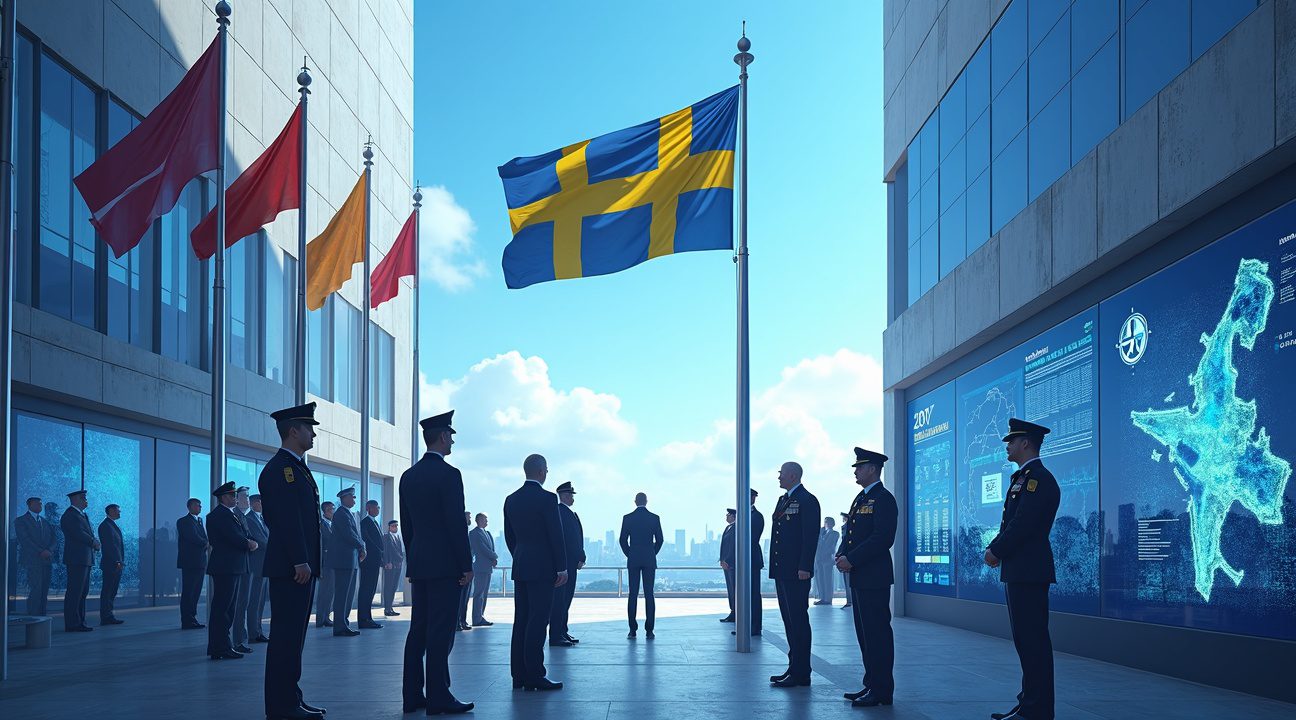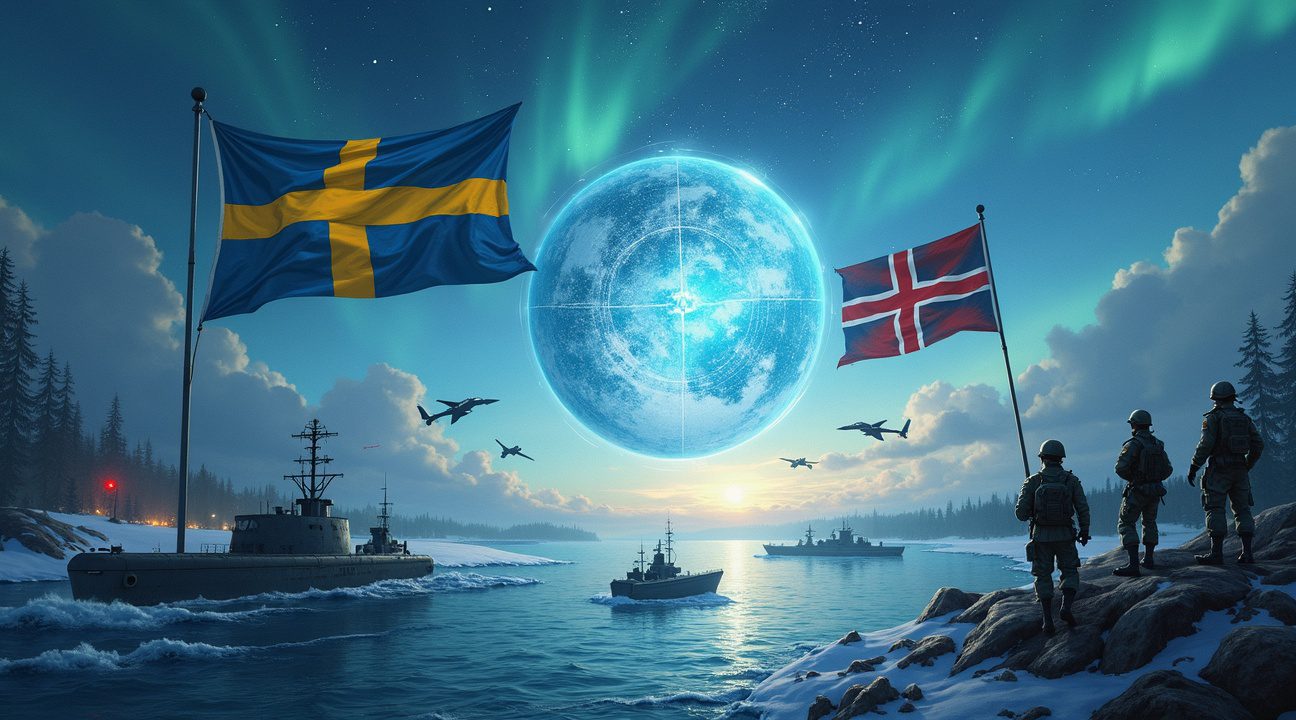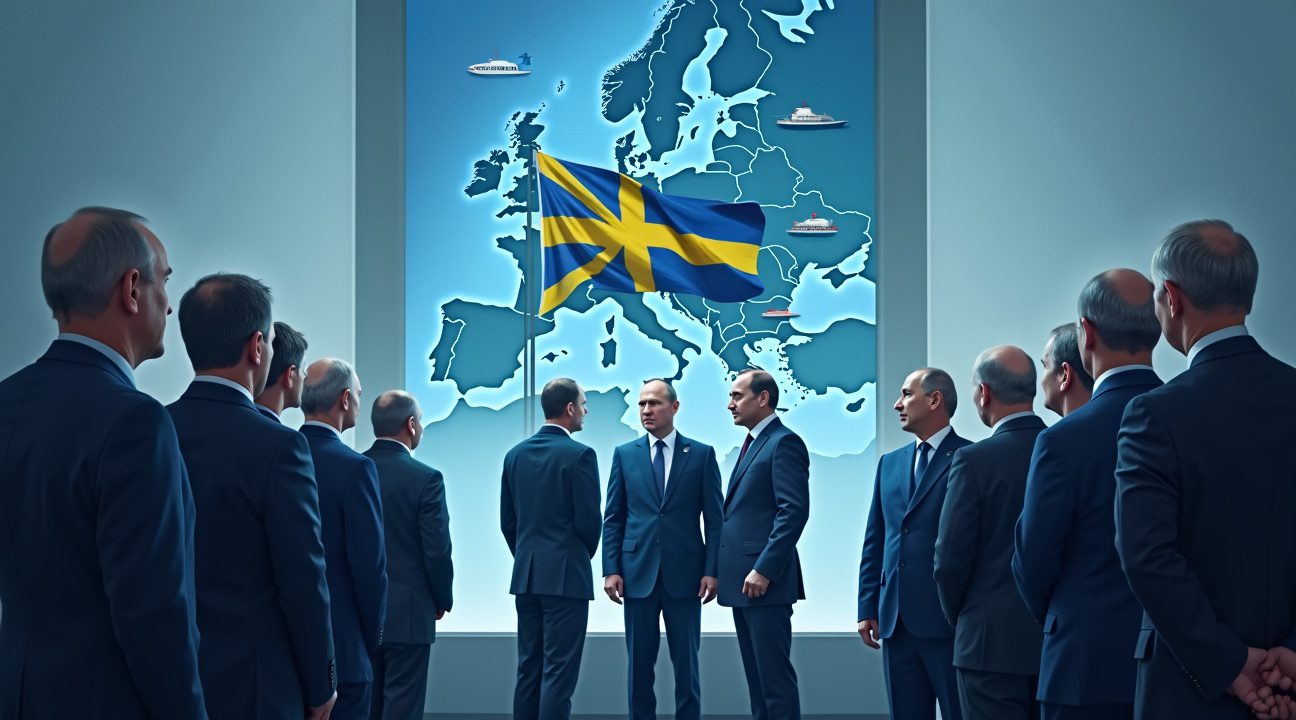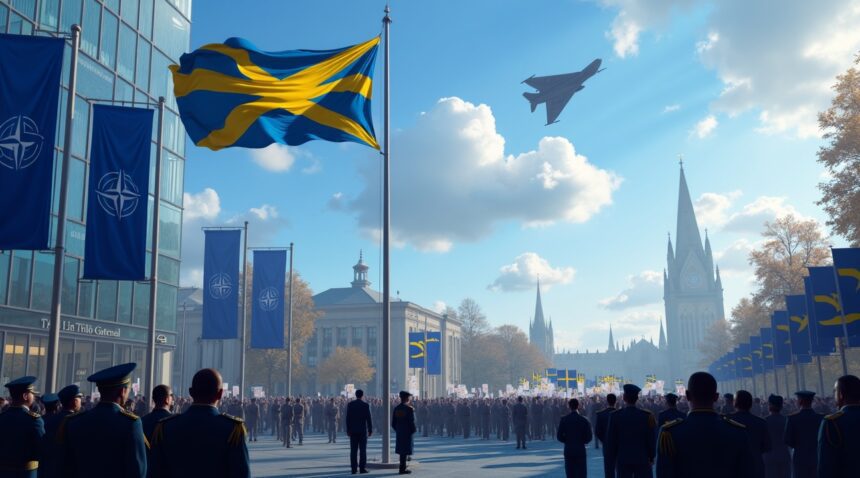Sweden officially became NATO’s 32nd member on March 7, 2024, ending over 200 years of neutrality in a historic policy shift driven by Russia’s invasion of Ukraine.
Key Takeaways
- Sweden’s NATO membership application took nearly two years to complete due to delays from Turkey and Hungary, with Turkey raising concerns about Swedish policies regarding Kurdish groups before finally ratifying in January 2024.
- The decision to join NATO represented a dramatic reversal of Swedish neutrality policy that had persisted since the early 1800s, with public support surging from below 40% to 60–70% following Russia’s invasion of Ukraine.
- Sweden’s membership creates a continuous NATO presence across all Nordic countries, extending the alliance’s border with Russia to over 2,600 kilometers and transforming the Baltic Sea into effectively a NATO-controlled waterway.
- The country brings significant military capabilities to NATO including advanced fighter aircraft, submarine technology, cyber warfare expertise, and a sophisticated defense industry led by companies like Saab.
- Sweden now falls under Article 5 collective defense guarantees, marking its first mutual defense pact in decades and providing protection from all 32 NATO members in exchange for contributing to alliance-wide security responsibilities.
Historic Moment: Sweden Breaks 200+ Years of Neutrality to Become NATO’s 32nd Member
March 7, 2024, marked a defining moment in European security when Sweden officially became NATO’s 32nd member. This decision shattered more than two centuries of Swedish neutrality, representing one of the most significant policy shifts in the country’s modern history.
The Path from Application to Membership
Sweden’s journey into NATO began on May 18, 2022, when the country submitted its membership application alongside Finland. Russia’s invasion of Ukraine fundamentally altered Sweden’s security calculations, making the traditional policy of non-alignment appear insufficient against growing regional threats. I’ve observed how rapidly geopolitical events can reshape long-held national strategies, and Sweden’s case exemplifies this transformation.
The Swedish Parliament demonstrated strong support for NATO membership when it approved the decision on March 22, 2023. With 269 votes in favor and only 37 opposed, lawmakers clearly recognized the changing security environment demanded a new approach. This overwhelming margin reflected not just political consensus but also shifting public opinion across Sweden.
The formal ceremonies surrounding Sweden’s accession highlighted the historic nature of this membership. Sweden’s flag was raised at NATO headquarters in Brussels on March 11, 2024, creating a powerful visual symbol of the country’s integration into the Atlantic alliance. For those following Sweden joins NATO developments, this moment represented the culmination of nearly two years of diplomatic efforts.
Sweden’s membership brings significant military capabilities to NATO, including:
- Advanced fighter aircraft
- Submarine technology
- Cyber warfare expertise
The country’s defense industry, particularly companies like Saab and their Gripen fighter jets, strengthens the alliance’s technological edge. Additionally, Sweden’s strategic position in the Baltic Sea provides NATO with enhanced coverage of this critical region.
The end of Swedish neutrality carries profound implications beyond military considerations. For generations, Sweden served as a diplomatic bridge between East and West, hosting peace negotiations and maintaining relationships across ideological divides. This historic neutrality had defined Swedish foreign policy since the early 1800s, making the NATO membership decision particularly momentous.
Sweden’s accession also completes the Nordic integration into NATO, with Finland having joined earlier in 2023. This development fundamentally alters the security architecture of Northern Europe, creating a unified defense posture across Scandinavia for the first time in modern history.

The Long Road to Ratification: Turkish and Hungarian Delays
Sweden’s journey to NATO membership stretched nearly two years, testing the Alliance’s unity and diplomatic patience. From the initial application in May 2022 to final ratification in March 2024, the process highlighted how bilateral concerns can significantly impact multilateral security arrangements.
Overcoming Turkish Objections
Turkey emerged as the primary obstacle to Sweden’s NATO bid, leveraging its veto power to address longstanding grievances. Turkish officials expressed serious concerns about Sweden’s policies regarding Kurdish groups, particularly the PKK (Kurdistan Workers’ Party), which Turkey designates as a terrorist organization. These diplomatic tensions centered on Sweden’s arms embargo against Turkey and its perceived leniency in extradition policies for individuals Turkey considered security threats.
The breakthrough came through intensive diplomatic negotiations culminating in a tripartite memorandum signed in June 2022. This agreement between Turkey, Finland, and Sweden established specific commitments, including Sweden’s pledge to lift arms restrictions and strengthen counterterrorism cooperation. Sweden joins NATO only after fulfilling these demanding conditions.
Turkish ratification finally arrived on January 25, 2024, following months of bilateral diplomatic negotiations. President Erdogan’s administration secured concrete assurances from Stockholm regarding enhanced security cooperation and policy adjustments on Kurdish-related issues.
Hungary’s Deliberate Pace
While 28 NATO members rapidly approved Sweden’s application, Hungary also delayed its ratification process. Hungarian officials cited procedural concerns and emphasized the need for thorough parliamentary review. Unlike Turkey’s substantive policy objections, Hungary’s delay appeared more tactical, possibly linked to broader EU-Hungary tensions over rule of law issues.
Hungary’s ratification on March 5, 2024, marked the final hurdle in Sweden’s NATO accession. This delay, though less contentious than Turkey’s objections, demonstrated how even smaller member states can influence Alliance expansion timelines.
The extended ratification process exposed the delicate balance between national sovereignty and collective security within NATO. Both Turkey and Hungary exercised their legitimate rights to thorough review, yet their delays highlighted the vulnerability of consensus-based decision-making in urgent security matters. Sweden’s patience and willingness to address Turkish concerns ultimately proved decisive in securing unanimous Alliance support.
From Neutrality to Alliance: Understanding Sweden’s Historic Policy Shift
Sweden’s transformation from a neutral nation to NATO’s newest member represents one of the most dramatic foreign policy reversals in modern European history. I can trace this shift back to Sweden’s long-standing neutral posture, which began in the 19th century and persisted through two World Wars and the Cold War era. This over 200-year tradition of non-alignment shaped Swedish identity and foreign policy until recent geopolitical events forced a complete reassessment.
The Evolution of Swedish Defense Policy
Sweden’s path to NATO membership didn’t happen overnight. After the Cold War ended, Sweden began gradually increasing its defense cooperation with Western allies while maintaining its official neutral stance. The country joined NATO’s Partnership for Peace program in 1994, creating formal channels for military cooperation without full membership commitments. This arrangement allowed Sweden to participate in peacekeeping operations and military exercises while preserving its non-aligned status.
By 2009, Sweden furthered its integration with Western defense structures through the European Union’s mutual defense declarations. These commitments marked a significant departure from traditional neutrality, though Sweden still avoided formal military alliances. The country also reinstated conscription in 2017, recognizing growing security concerns in the Baltic region and increased Russian military activity.
The Ukrainian Crisis as a Catalyst
Russia’s full-scale invasion of Ukraine in February 2022 fundamentally altered Swedish security calculations and public sentiment. I observed how this aggressive act shattered assumptions about European security and forced Sweden to confront the limitations of neutrality in an increasingly unstable neighborhood. The invasion demonstrated that non-alignment couldn’t guarantee protection against authoritarian aggression.
Public opinion shifted dramatically during this period. Support for NATO membership surged from below 40% in previous decades to 60-70% during spring and summer 2022, according to polling data. This remarkable change reflected Swedish citizens’ recognition that their country’s geographical proximity to Russia and the Baltic states made neutrality a potentially dangerous luxury.
Political leaders responded to both the security threat and shifting public sentiment. Sweden’s traditional reluctance to join military alliances gave way to pragmatic security concerns, leading to the historic decision to apply for NATO membership alongside Finland. This policy reversal abandoned centuries of neutrality in favor of collective security guarantees.
Sweden’s NATO membership represents more than just a military alliance; it signifies a fundamental reorientation of Swedish strategic thinking. The country moved from relying on neutrality as its primary security tool to embracing multilateral defense cooperation as the most effective deterrent against regional threats.
Strategic Game-Changer: How Sweden Strengthens NATO’s Northern Front
Sweden’s membership creates a powerful Nordic defense bloc that fundamentally alters NATO’s strategic landscape. All Nordic countries—Denmark, Norway, Iceland, Finland, and Sweden—now stand united under the alliance banner, transforming the Baltic Sea into virtually a NATO lake. This geographic shift grants the alliance unprecedented control over critical northern waterways and establishes a formidable defensive perimeter.
The numbers tell a compelling story about NATO’s expanded reach. Combined with Finland’s earlier accession, Sweden joins NATO to extend the alliance’s border with Russia to over 2,600 kilometers. This massive expansion forces Moscow to recalculate its military positioning and defensive strategies across its entire western frontier.
Sweden brings substantial military capabilities that enhance NATO’s operational strength. The nation maintains one of Europe’s most advanced defense industries, producing cutting-edge fighter jets, submarines, and sophisticated weapons systems. Companies like Saab and BAE Systems Bofors represent decades of innovation in military technology, from the Gripen fighter aircraft to advanced radar systems that bolster air defense capabilities.
Enhanced Military Contributions and Spending
Sweden’s commitment to NATO standards includes significant increases in defense spending. The country plans to reach NATO’s 2% GDP target for military expenditures, representing a substantial boost to both national capabilities and alliance resources. Key areas receiving enhanced focus include:
- Baltic Sea maritime security operations and submarine warfare capabilities
- Arctic surveillance and reconnaissance missions utilizing Sweden’s cold-weather expertise
- Cyber defense initiatives leveraging Sweden’s technological advancement
- Joint training exercises that integrate Swedish forces with existing NATO structures
- Intelligence sharing networks that strengthen Baltic and Arctic monitoring
The strategic implications extend far beyond simple geography. Sweden’s position creates an integrated Nordic defense framework that covers both Baltic Sea security and Arctic NATO operations. Russian naval movements from Kaliningrad now face monitoring from multiple angles, while Arctic territories receive enhanced surveillance coverage.
Sweden’s advanced submarine fleet proves particularly valuable for Baltic operations, where underwater warfare capabilities determine naval superiority. The country’s expertise in cold-weather operations and Arctic conditions fills critical gaps in NATO’s northern strategy, especially as climate change opens new Arctic shipping routes and resource exploration opportunities.
This Nordic consolidation establishes a defensive corridor that connects the Baltic states to the broader alliance framework. Estonia, Latvia, and Lithuania now benefit from strengthened supply lines and reinforcement routes, reducing their strategic vulnerability. The integrated air defense systems spanning from Norway to Poland create overlapping coverage that significantly complicates any potential Russian military planning in the region.
Article 5 Protection: Sweden Gains Full NATO Defense Guarantees
Sweden’s NATO membership, which became effective March 7, 2024, brought the Nordic nation under the protective umbrella of Article 5 for the first time since the Cold War era. This fundamental shift represents Sweden’s entry into its first mutual defense pact in decades, fundamentally altering the country’s security posture and regional defense dynamics.
Article 5 stands as NATO’s cornerstone collective defense provision, stating that an attack against one member constitutes an attack against all. For Sweden, this means that any military aggression against Swedish territory would trigger a coordinated response from all 32 NATO members. This represents a dramatic departure from Sweden’s traditional policy of military neutrality, which had defined the nation’s approach to international security for over two centuries.
Enhanced Security Through Allied Support
The integration of Sweden under NATO’s defense guarantees brings several critical advantages:
- Access to the alliance’s integrated command structure and intelligence sharing networks
- Participation in joint military exercises and standardized defense protocols
- Protection under the nuclear umbrella provided by NATO’s nuclear-capable members
- Enhanced interoperability with allied forces through standardized equipment and procedures
- Strategic coordination with neighboring Nordic NATO members Norway, Denmark, and Iceland
The United States has demonstrated strong political and military support for Sweden’s integration, viewing the Nordic nation as a valuable strategic partner in the Baltic Sea region. European allies have similarly welcomed Sweden’s membership, recognizing that Swedish defense capabilities strengthen the alliance’s overall deterrent effect against potential adversaries.
Sweden’s inclusion fundamentally changes the regional deterrence landscape, particularly in the Baltic Sea area. The nation’s advanced defense industry, including companies like Saab and their cutting-edge military technologies, now contributes directly to NATO’s collective defense capabilities. Swedish submarines, fighter aircraft, and missile defense systems enhance the alliance’s ability to project power and maintain security in Northern Europe.
The defense guarantees extend beyond traditional military protection to include cyber defense, space security, and hybrid warfare threats. Sweden’s expertise in these domains, developed through years of innovation and strategic planning, now supports the broader alliance while benefiting from shared intelligence and coordinated responses to emerging security challenges.
This membership marks a historic transformation in European security architecture, with Sweden moving from a position of armed neutrality to full integration within the Western defense framework. The mutual defense obligations create both enhanced protection for Sweden and expanded responsibilities, as the nation now contributes to the collective security of all NATO members across the globe.

Russian Response and Geopolitical Implications
Russia’s reaction to Sweden’s NATO membership proved remarkably restrained compared to earlier responses to alliance expansion. President Vladimir Putin and Defense Minister Sergey Shoigu voiced their opposition to NATO enlargement, cautioning that such moves could escalate regional tensions across Europe. I find it significant that Russian officials maintained a measured tone, particularly given the timing following the Ukraine invasion.
Moscow’s Strategic Calculations
Russian leadership downplayed the immediate security threat posed by Sweden joining NATO, with officials emphasizing that their primary concern centers on potential military infrastructure deployment rather than membership itself. Moscow’s position suggests they view symbolic expansion differently from practical military positioning. This calculated response marks the first major Russian reaction to NATO enlargement since launching their invasion of Ukraine, indicating possible strategic recalibration.
Intelligence analysts note that Russia’s subdued response may reflect their current military commitments and resource constraints. Putin’s administration appears to be distinguishing between NATO membership and actual military asset deployment, suggesting they’re prioritizing immediate threats over longer-term strategic concerns.
Public Opinion Shifts and Diplomatic Celebrations
Public support for NATO membership in Sweden experienced a dramatic surge following Russia’s invasion of Ukraine, transforming decades of neutrality policy within months. I observe that Swedish citizens moved from skepticism about military alliances to overwhelming endorsement of NATO membership, fundamentally altering their nation’s security outlook.
The flag-raising ceremony at NATO headquarters in Brussels symbolized this historic realignment, with Swedish officials and citizens celebrating their country’s integration into the Atlantic alliance. This public celebration contrasted sharply with Russia’s muted diplomatic protests, highlighting the divergent perspectives on European security architecture.
Sweden’s membership represents a significant geopolitical shift that extends beyond bilateral relations with Russia. The addition creates a continuous NATO presence across Scandinavia, potentially complicating Russian naval operations in the Baltic Sea and altering regional power dynamics. Military experts suggest this development could influence future Russian strategic planning, particularly regarding their northwestern borders.
The contrast between Russian rhetoric and actual response reveals important insights about Moscow’s current priorities and capabilities. While expressing displeasure with NATO enlargement, Russia’s relatively restrained reaction suggests recognition of their limited options for meaningful retaliation against a process they cannot realistically prevent.

Sources:
Wikipedia: “Sweden–NATO relations”
Government of Sweden: “Historical relations between Sweden and NATO”
Wilson Center: “From Partner to Ally: Sweden’s First Year in NATO”
Atlantic Council: “When will Sweden and Finland join NATO? Tracking the ratification process across the alliance”
PRIF Blog: “Sweden’s Accession to NATO: What Is behind the Decision?”
Wikipedia: “Enlargement of NATO”
House of Commons Library: “NATO enlargement: Sweden and Finland”


